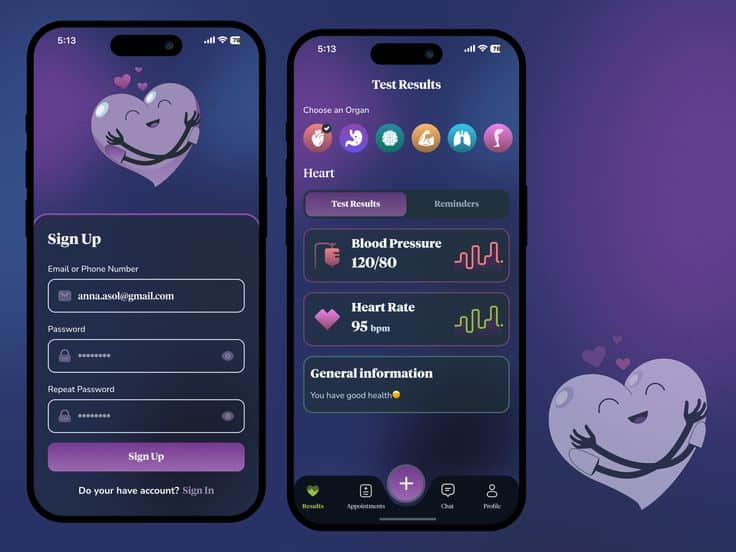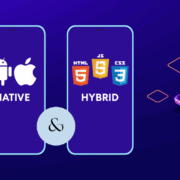Patient-Centered Mobile Apps: Features Users Demand Most
Did you know that over 60% of patients prefer using mobile apps to manage their health and communicate with healthcare providers?
That’s a huge shift in how people engage with their well-being. But here’s the catch—most healthcare apps fail to keep users engaged because they lack the features patients look for.
Building a healthcare mobile app isn’t just about offering basic functions. Patients today expect more. They want apps that are patient-centered, secure, and packed with features that make managing their health easier and more personal.
So, what exactly are users looking for in patient-centered mobile apps? This blog breaks down the most in-demand features that can transform your healthcare mobile app from just another download to a tool patients rely on every day.
Understanding Patient-Centered Healthcare Mobile Apps
A patient-centered healthcare mobile app is designed to prioritize the needs, preferences, and convenience of patients. These apps focus on improving patient engagement, enhancing access to healthcare services, and supporting better health outcomes.
By offering user-friendly features and personalized experiences, they empower patients to play an active role in managing their health. A successful patient- centered app must combine usability, security, and functionality to deliver real value to patients as well as healthcare providers.
Must-Have Features for Patient-Centered Mobile Apps
To create a truly patient-centered mobile app, it’s crucial to include features that directly address patient needs and improve healthcare experiences. Below are the most in-demand features that users expect in modern healthcare apps.
Doctor Profile Lookup
Patients need access to comprehensive information about healthcare providers to make informed decisions. A Doctor Profile Lookup feature allows users to browse through a list of available doctors, and view their qualifications, specialties, experience, and patient reviews.
Adding availability schedules and the option to book appointments directly from the profile can make the user experience seamless. This feature fosters trust by helping patients choose a provider who best matches their health needs and preferences.
Appointment Scheduling
Convenient and flexible appointment booking is one of the most essential features of patient- centered apps. This feature allows patients to schedule, reschedule, or cancel appointments without making phone calls or visiting clinics.
Integration with personal calendars, automated reminders, and real-time availability updates helps reduce the chances of missing appointments for patients. For healthcare providers, it optimizes resource management, while for patients, it ensures a hassle-free healthcare experience.
Reminders and Notifications
Patients often struggle to keep up with medical appointments, medication schedules, and follow-up care. Reminders and notifications are essential for improving adherence to treatment plans. This feature sends timely alerts for upcoming appointments, medication intake, and routine health check-ups.
Notifications can also inform users about new test results, vaccine availability, or general health tips. This proactive communication keeps patients engaged and promotes better health outcomes by reducing missed treatments and appointments.
Doctor-Patient Communication
Secure and direct communication between patients and healthcare providers is a key feature of patient- centered apps. This includes in-app messaging, video consultations, and voice calls, enabling patients to ask questions, share concerns, and receive timely responses without needing an in-person visit.
Real-time communication improves patient satisfaction, speeds up decision-making, and helps prevent health issues from escalating due to miscommunication or delayed responses.
Symptom Checker
A built-in symptom checker allows users to input their health symptoms and receive preliminary guidance on possible conditions. Powered by AI or medical databases, this feature can assess symptoms and recommend appropriate next steps such as self-care tips, scheduling a consultation, or seeking immediate medical attention.
Symptom checkers provide users with a sense of control over their health and can reduce unnecessary clinic visits. This feature should always include disclaimers and encourage users to consult professionals for accurate diagnoses.
Integration with Medical Devices
Health-conscious individuals are increasingly using wearables and medical devices to monitor their well-being. Integrating healthcare mobile apps with devices like fitness trackers, blood glucose monitors, and heart rate monitors allows seamless data sharing.
This feature provides real-time insights into vital health metrics such as physical activity, blood pressure, sleep quality, and glucose levels. This continuous monitoring helps patients manage chronic conditions and supports preventive healthcare.
Access to Medical Records
Having on-demand access to personal health records empowers patients to take control of their health. This feature allows users to securely view their electronic health records (EHRs), including lab results, medical history, imaging reports, and treatment plans.
Patients can easily share this information with other healthcare providers, facilitating better-coordinated care. Transparency and easy access to health information encourage patients to stay engaged in their care.
Prescription Tracking
Managing medications can be challenging, especially for patients with multiple prescriptions. A prescription tracking feature helps users organize their medications, monitor dosages, and stay on top of refill schedules.
The app can send reminders for when to take medications, notify users about upcoming refills, and provide information about side effects and potential drug interactions. This feature not only improves medication adherence but also reduces the risk of missed or incorrect dosages, contributing to better health outcomes.
Health Education Resources
Access to accurate and up-to-date health information empowers patients to make informed decisions about their care. A health education resources section can provide articles, videos, and infographics on various health topics, wellness tips, disease prevention, and treatment options.
Personalizing content based on user health profiles ensures relevance and engagement. This feature encourages proactive health management and supports patient learning outside clinical visits.
Emergency Assistance and SOS Feature
A critical feature for patient safety is an emergency assistance or SOS button. This allows users to quickly contact emergency services or notify designated contacts during a health crisis.
Using this feature, the mobile app can share the patient’s real-time location and provide medical details such as allergies, existing conditions, and medications to first responders. This feature is particularly useful for elderly patients, individuals with chronic conditions, or those at risk of medical emergencies.
The Future of Patient-Centered Mobile Apps
The future of patient-centered mobile apps is being shaped by emerging technologies that prioritize personalization, security, and accessibility.
Artificial Intelligence (AI) and Machine Learning (ML) are driving personalized health insights and symptom checkers, enabling apps to deliver smarter healthcare solutions. On the other hand, telemedicine integration is expanding, offering remote consultations and e-prescriptions for greater convenience.
For healthcare providers and facilities, staying ahead of these trends is critical to building innovative apps that improve patient care, boost user engagement, and ensure long-term success in the healthcare industry.
The Wrap Up
Building a successful patient-centered mobile app requires more than just basic functionality, it demands features that truly meet patient needs and improve healthcare experiences.
For healthcare providers, focusing on user-driven features in their mobile apps and staying ahead of industry trends is key to creating apps that stand out in the market.
By prioritizing personalization, data security, and seamless healthcare access, developers can deliver innovative solutions that improve patient outcomes and build long-term user trust. Investing in these essential features today sets the foundation for more impactful and widely adopted healthcare mobile apps in the future.




